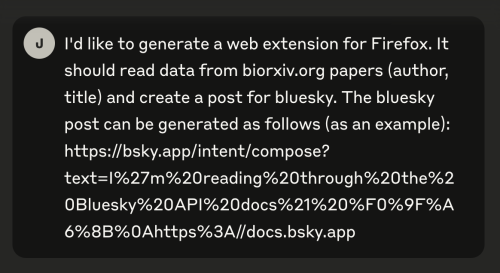Painless Preprint Posting
Posted by Joachim Goedhart, on 30 April 2025
One of my favourite uses of social media is sharing (and discovering) new preprints that seem relevant for my field. Rewardingly, posting preprints is usually well-received by followers. Since there used to be a button on the bioRxiv website for posting preprints on twitter/X, this was a relatively simple thing to do. However, twitter/X is abandoned and the majority of folks that I follow are now on Bluesky. So, now I’m posting preprints (among other sciency content) on BlueSky. Unfortunately, at the time of writing this piece, there are no buttons on the bioRxiv page that facilitate this process.
The information that I collect for posting the preprint are the title, an author and the link to the preprint, so that involves quite some copy-pasting between different browser windows. To simplify this process, I looked into web extensions (footnote 1). The web extensions that I needed was not there, so I decided to explore how easy it is to make one. It turns out that web extensions are written in Javascript and I have zero experience with this language. So, I turned to AI for help.

First, I tried ChatGPT, which wasn’t very successful. Then, I turned to Claude.ai and I got a working prototype after my first prompt. After a second prompt I already had something quite decent. Then, I decided to polish the web extension, e.g. add an icon, add only the name of the last author to the post and extend the functionality to medRxiv. This process involved several iterations of prompts and tests. The main issue is that new functionality has to be added without breaking the existing functions. So there were several rounds where the code stopped working, and I had to feed the error to Claude.ai and ask for repair. I also asked several times to ‘simplify the code’, to keep the code concise. In the end (17 prompts in total), I got a nicely working extension that shows a blue icon when a preprint can be shared and when the icon is clicked a post for BlueSky is prepared. This is exactly what I needed! The code for the extension (for the Firefox web browser) and an instruction to install it are available here: https://github.com/JoachimGoedhart/Rxiv2BlueSky

Besides the tangible result, I also gained some insight of how Large-Language Models can augment the development of software. Without any knowledge of web extensions, nor the necessary language needed to create one, I was able to generate a nicely working add-on, by simply defining what I wanted to achieve. Later on, I learned that this process is known as ‘vibe-coding’, a term introduced by Andrej Karpathy. The exciting point is that vibe coding enables non-coders to generate working code. For me, vibe coding a web extension was an amazing experience and it felt like I gained some kind of superpower.
Footnotes
Footnote 1: I wasn’t familiar with web extensions at all and it turned out that there is an ecosystem of different extension for different browsers and in some cases developers have to pay to publish their extension. Since I’m commonly using Firefox (in some cases Safari), and since publishing extensions (or add-ons) for Firefox is free, I decided to go for Firefox as the browser.


 (3 votes)
(3 votes)